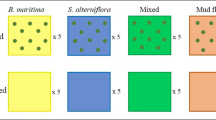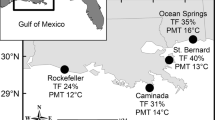Abstract
Field observations of seedlings and saplings of Avicennia marina showed patterns that correlated with salinity, light and sediment. Models that account for these observations were subsequently tested in a series of field experiments. Establishment varied within an estuary under controlled conditions but was not related to salinity or sediment type. Seedling survival was uniform over 3 years regardless of position in estuary and sediment type. Seedling densities and survival under canopies or in canopy gaps were not significantly different. However, seedling growth and density of saplings were greater in canopy gaps. Experiments involving manipulations of canopies showed no differences in seedling survival under canopies or in light gaps, but addition of slow-release fertilizer enhanced growth and survival in canopy gaps and under canopies. Long-term comparison of areas denuded of a canopy and with sediment disturbance showed enhanced establishment and survival when compared with areas with canopy gaps but with undisturbed sediments. Overall there appears to be no restriction to establishment of propagules within mangrove stands other than the supply of propagules and tidal or wave action. In contrast, recruitment to the sapling stage appears to be restricted by light and sediment resources. We suggest that propagules need to establish in a regeneration niche for seedling recruitment to the sapling stage. This differs from the view that seedlings in the under-storey are analogous to a seed pool in the soil.
Similar content being viewed by others
References
Attiwill PM, Clough BF (1980) Carbon dioxide and water vapour exchange in the white mangrove. Photosynthetica 14:40–47
Ball MC (1988) Ecophysiology of mangroves. Trees 2:129–142
Ball MC, Critchley C (1982) Photosynthetic response to irradiance by the grey mangrove, Avicennia marina grown under differing light regimes. Plant Physiol 74:7–11
Bunt JS, Williams WT, Clay HT (1982) River water salinity and the distribution of mangrove species along several rivers in North Queensland. Aust J Bot 30:401–412
Burns BR, Ogden J (1985) The demography of the temperate mangrove [Avicennia marina (Forsk.) Vier.] at its southern limit in New Zealand. Aust J Ecol 10:125–133
Clarke LD, Hanno NJ (1971) The mangrove swamp and salt marsh communities of the Sydney district. IV. The significance of species interaction. J Ecol 59:535–553
Clarke PJ (1993) Dispersal of grey mangrove (Avicennia marina var. australasica) propagules in south-eastern Australia. Aquat Bot
Clarke PJ, Myerscough PJ (1991a) Buoyancy of Avicennia marina propagules in south-eastern Australia. Aust J Bot 39:77–83
Clarke PJ, Myerscough PJ (1991b) Floral biology and reproductive phenology of Avicennia marina in south-eastern Australia. Aust J Bot 39:283–293
Clarke PJ, Myerscough PJ (1993) The intertidal distribution of the grey mangrove (Avicennia marina) in southeastern Australia; the effects of physical conditions, interspecific competition, and predation on establishment and survival. Aust J Ecol (in press)
Grant DL, Clarke, PJ, Allaway WG (in press) Effects of oil spills on seedling of Avicennia marina. J Mar Exp Biol Ecol
Hutchings P, Saenger P (1987) Ecology of Mangroves. University of Queensland Press. St Lucia
Osborne K, Smith TJ (1990) Differential predation on mangrove propagules in open and closed canopy forest habitats. Vegetatio 89:1–6
Quinn RH, Breamer JP (1984) Wallum Creek, a study of the regeneration of mangroves. In: Coleman JR, Covacevich J, Davie P (eds) Focus on Stradbroke, Boolarong Publishers, Brisbane
Stocker GC (1987) Tree species diversity in rainforests — establishment and maintenance. In: Kitching RL (ed) The ecology of Australia's wet tropics. Proc Ecol Soc Aust 15:39–47
Smith TJ (1987a) Effects of seed predators and light level on the distribution of Avicennia marina (Forsk.) Vierh. in tropical, tidal forests. Estuarine Coastal Shelf Sci 25:43–51
Smith TJ (1987b) Effects of light and intertidal position on seedling survival and growth in tropical tidal forests. J Exp Mar Biol Ecol 110:133–146
Thom BG (1967) Mangrove ecology and deltaic geomorphology, Tabasco, Mexico. J Ecol 55:301–343
Ward CJ, Steinke TD, Ward CM (1986) Mangroves of the Kosi System, South Africa: their re-establishment since mass mortality in 1965/66. S Afr J Bot 52:501–512
Author information
Authors and Affiliations
Rights and permissions
About this article
Cite this article
Clarke, P.J., Allaway, W.G. The regeneration niche of the grey mangrove (Avicennia marina): effects of salinity, light and sediment factors on establishment, growth and survival in the field. Oecologia 93, 548–556 (1993). https://doi.org/10.1007/BF00328964
Received:
Accepted:
Issue Date:
DOI: https://doi.org/10.1007/BF00328964




